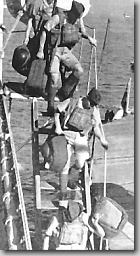The Defence of Hong Kong

Canadians disembarking at Hong Kong, 1941
It was against Japan in the defence of Hong Kong that Canadian soldiers were first committed to battle during the Second World War.
As tension in the Pacific grew, the vulnerability of the outpost of Hong Kong became more and more apparent. It was recognized that in the event of a war with Japan, it could neither be held nor relieved. Hong Kong would be considered an outpost to be held as long as possible, but without further reinforcement. This decision was reversed late in 1941 when it was argued that reinforcement would serve as a deterrent to hostile action by Japan, and also have an important moral effect throughout the Far East. Accordingly, Canada was asked to provide one or two battalions for the purpose.
The Royal Rifles of Canada and The Winnipeg Grenadiers, under the command of Brigadier J.K. Lawson, sailed from Vancouver on October 27, 1941. These Canadian units had not received training as front-line troops, but war with Japan was not considered imminent and it was believed that they were going to Hong Kong for garrison duty. Tragically, only a few weeks later, they were to become the first Canadian units to fight in the Second World War, when in almost simultaneous attacks on Pearl Harbor, Northern Malaya, the Phillipines, Guam, Wake Island and Hong Kong, Japan brought war to the Pacific.
The Crown Colony of Hong Kong consisted of Hong Kong Island and the adjacent mainland areas of Kowloon and the New Territories. In 1941 the Japanese were in control of much of the area north of the New Territories-China border.
For the defence of the colony Major-General G.M. Maltby, commander of Hong Kong, had only a total force of some 14,000 which included naval and air force personnel and many non-combatants. His military force was made up of British, Canadian and Indian regiments as well as the Hong Kong Volunteer Defence Corps. Further, the defence of Hong Kong would have to be carried out without any significant air or naval defence. The Kai Tak Royal Air Force base on Hong Kong had only five airplanes, flown and serviced by seven officers and 108 airmen. The nearest fully-operational RAF base was in Malaya, nearly 1,400 miles away. Nor could Hong Kong offer much in the way of naval defence. All major naval vessels had been withdrawn, and only one destroyer, several gunboats and a flotilla of motor torpedo boats remained.
The Japanese attack, however, did not take the garrison by surprise, for in spite of the optimism nothing was left to chance. The defence forces were made ready. Three battalions would man a ten-mile line (the Gin Drinkers' Line) stretching across rugged hill country and pocked by trenches and pillboxes. This position would protect Kowloon, the harbour and the northern part of Hong Kong Island from artillery fire from the land, unless the enemy mounted a major offensive. In that event, the mainland positions would provide time to complete demolitions, clear vital supplies, and sink shipping in the harbour. The remaining forces were to be concentrated on the island and prepared to defend against any Japanese attack from the sea.
- Date modified: